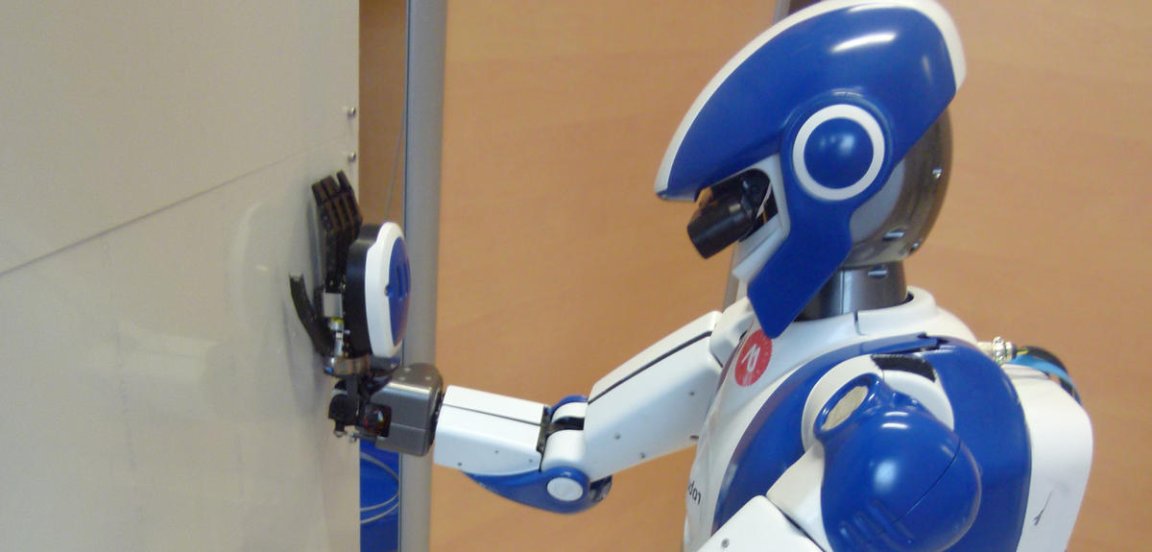
Joint Robotics Laboratory and the Airbus Group have merged together to launch a new Joint Research Program. This new partnership aims to develop humanoid robots that will be used for aviation manufacturing.
“Given the unique nature of aviation assembly and the specialized character of the tasks involved, Airbus Group has very well-defined needs,” explains Abderrahmane Kheddar, the director of the JRL. “For instance, robots must be capable of navigating through narrow spaces such as fuselages, and executing complex tasks from a variety of positions. In short, the manufacturer needs humanoid robots that can make human movements such as kneeling or leaning, and that can perform more sophisticated functions, such as screwing or torqueing,” adds Adrien Escande, the leader of the joint research program.
Since 2004, the team has been making advanced functions on the robots a reality rather than just science fiction.
“By combining Japanese expertise in hardware and robotics along with advanced French knowledge of mathematics and algorithms, we made encouraging initial progress in fields such as robot design and haptics, or tactile perception,” continues Kheddar. “We are now building on these achievements to develop multi-contact locomotion, which enables humanoid robots to move using not just their feet, but also other body parts such as elbows, knees, and hands, as a human would when crawling.”
New breed of humanoid robots
The project is called COMANOID (Multi-Contact Collaborative Humanoids) European research. They are focusing on the qualities that the robots will need to assist the aviation industry. In short, these humanoids need to be able to kneel, lean, and balance themselves on uneven surfaces. They have to be “trained” in safely moving around the passengers, the aircraft, and their fellow humanoids. They also need to perform tasks, like simple repairs and placing objects in their proper storage places.
The team is expanding these basics by working on more intricate movements that require improvement in two key areas: robot control and planning.
“To illustrate what this means, try to imagine a rock-climber,” suggests Adrien Escande. “To take the next step on a rock face, they must think ahead by identifying possible foot and handholds, and by deciding which movements to make, and in what sequence. This is the planning function. Then there is the control function, which enables the climber to adapt their movements in real-time based on uncalculated events, such as a slip or a gust of wind. We are currently using numerical optimization techniques and advanced algorithms to improve capacity in both of these areas.”
One example is having the humanoid open a panel in an aircraft at knee level. It has to accurately calculate its movements by knowing where to kneel, how to grasp handles, and where to place its hands for support and balance. The calculations should allow the humanoid to react immediately. In a situation where the humanoid needs to assist a human worker, it should be able to anticipate the human’s movements in real time. They should be able to work hand in hand in milliseconds.
No easy task.
To achieve this amazing feat, the researchers needed to model the robot’s perception and behavior. Everything that the humanoid does is based from mathematics. An action is translated as a mathematical problem, which then becomes an equation. The next step is to “solve” the mathematical problem using algorithms developed by scientists.

In the example given previously, about a humanoid opening a panel at knee-length, several calculations need to take place, such as balance, distance and counter-balancing force. For humans, our body adjusts automatically in these types of situations. For robots, we need to program them to “adjust” automatically using algorithms like bipedal locomotion, fall control, and contact force distribution.
The robots of the future
With all of the impressive algorithms in place, the team is still trying to improve the robot’s learning capacity. They plan to “teach” these machines to eventually search information over the Internet by themselves.
This “self-learning” project is called RoboHow.
Ultimately, the project will help robots learn new tasks such as cooking or putting paper in the printer simply by reading information from the Internet. These instructions will be stored in their knowledge base for future use. These various sources are then integrated by the robot in order to carry out the task. Eventually, they want to see robots that are independent and can find solutions to problems on their own.
Aviation robots
Aside from airplanes, the humanoid robots will be adapted for helicopter and aerospace activities. Soon, they will also be used in other industries such as train or ship building, where there are more complex tasks at hand.
“It should be very clear that these humanoids are not intended to replace workers, but rather to offer them better working conditions by freeing them from chores that are physically-taxing or that involve contact with pollutants,” concludes Kheddar. “This enables workers to focus on the more skilled and value-added aspects of their activities. In other words, these robots are sophisticated tools intended to assist them as part of a synergistic human-robot collaboration.”